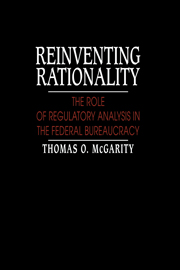Book contents
- Frontmatter
- Contents
- Acknowledgments
- Abbreviations
- Introduction
- Part I The clash of regulatory cultures
- Part II Regulatory analysis in theory and practice
- Part III Structuring regulatory analysis into the decisionmaking process
- 11 Roles for the regulatory analyst
- 12 The hierarchical model
- 13 The outside advisor model
- 14 The team model
- 15 The adversarial model
- 16 A hybrid model
- 17 Selecting the right model
- Part IV Review of regulatory analysis
- Part V Conclusions
- Notes
- Bibliography
- Index
11 - Roles for the regulatory analyst
Published online by Cambridge University Press: 16 October 2009
- Frontmatter
- Contents
- Acknowledgments
- Abbreviations
- Introduction
- Part I The clash of regulatory cultures
- Part II Regulatory analysis in theory and practice
- Part III Structuring regulatory analysis into the decisionmaking process
- 11 Roles for the regulatory analyst
- 12 The hierarchical model
- 13 The outside advisor model
- 14 The team model
- 15 The adversarial model
- 16 A hybrid model
- 17 Selecting the right model
- Part IV Review of regulatory analysis
- Part V Conclusions
- Notes
- Bibliography
- Index
Summary
Because institutions lack a centralized nervous system steered by a single brain, institutional decisionmaking tends to be very different from individual decisionmaking. Most regulatory decisions are the products of numerous encounters between the various institutional entities that have roles to play in the decisionmaking process, and they therefore represent a synthesis of many views. A requirement that agencies prepare regulatory analysis documents does not by itself ensure that comprehensive analytical rationality will play a role in regulatory decisionmaking. Bulky analytical documents can be ignored by subordinate decisionmaking units, and upper-level decisionmakers in most agencies simply do not have time to absorb the contents of lengthy regulatory analysis documents. The documents themselves are likely to affect agency decisionmaking only to a very modest degree.
Yet, regulatory analysis requirements can influence agency decisionmaking in a more subtle fashion. Once the agency establishes a regulatory analysis office with an institutional stake in comprehensive analytical thinking, agency decisionmakers can adjust how that kind of thinking affects agency decisions by structuring the decisionmaking process to give that office greater or lesser prominence. Hence, to discover the real role that analysis plays in an agency, one must focus attention on the role of the regulatory analyst, rather than on the document that the analyst prepares. The role that the analyst plays will, to a very large extent, determine the degree to which analysis affects regulatory agency decisionmaking.
Chapter 11 describes several roles that regulatory analysts can play in the regulatory decisionmaking process and examines some of the advantages and disadvantages of each of those roles.
- Type
- Chapter
- Information
- Reinventing RationalityThe Role of Regulatory Analysis in the Federal Bureaucracy, pp. 179 - 190Publisher: Cambridge University PressPrint publication year: 1991



